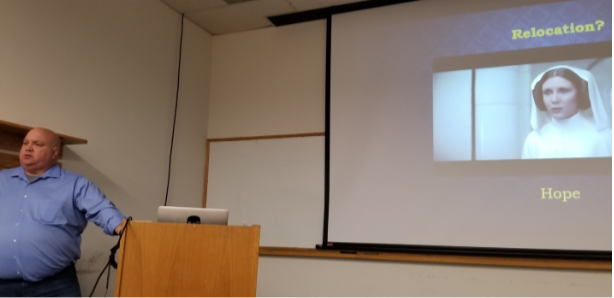Phased Renovation of McKeldin Library Conservation Lab
Mark Coulbourne (UMD Libraries Librarian), Bryan Draper (UMD Libraries Conservation Manager), and Carla Montori (UMD Libraries Head of Preservation)
University of Maryland Libraries, College Park
Summarized by: Beth Knight, Textile Conservator in private practice
Headcount: 20
At WCG’s annual 3-Ring Circus, Bryan Draper and Mark Coulbourne of the McKeldin Library at the University of Maryland Libraries shared how their conservation lab space has evolved over the decades to adapt to their needs and resources.

Bryan began by outlining the history of the preservation department, which began in the 1980s. After the west wing was added to the library in 1994, the Preservation Department moved into two windowless rooms in the basement with triple the space, where the lab remains today. In the early days, the department was geared toward general collections conservation and had 15 full time equivalent employees by 2006. Staffing numbers varied in the 2000s, with the result that by the end of the decade, a backlog had accumulated and the department refocused on more Special Collections treatment. As work progressed, the department realized that they needed a new lab arrangement to accommodate the smaller staff and different priorities. In 2010, planning began for a new lab in Hornbake Library. Two years later without progress on the new lab, the department staff instead started the first major reorganization of the existing lab space. The old lab configuration had 13 foot long benches, built-in storage that was not being used, and less than ideal work stations like the cutting area near the sink that hindered the new workflow. From 2012 to today, the staff have been through several reorganization campaigns to increase the flexibility of their existing space while plans for the new lab are on hold.
Mark discussed the specific steps that were taken including clearing out clutter, creating smaller benches which include a floating space for interns and student workers as needed, installing new lighting to replace task lamps that occupied valuable bench space, removing long storage shelving units in the middle of the lab to open up the space, and clearing areas between the benches for easier flow throughout the lab. The goal of these reorganizations was to transform the space from crowded and static to open and flexible. The lab and needs of the collection are still evolving, so Mark outlined some of the department’s future goals and some lessons learned over the years. As the general collection is dwindling, the focus remains on Special Collections but more preparation is being done for digitization. This includes plans for a photo documentation studio in the newly opened spaces in the lab. Purchasing movable furniture and removing old furniture will allow for easier redesign in the future, and Mark recommended spreading purchases over multiple fiscal years to ease the burden of tight budgets. Going forward, the department staff hope to seek out ideas from peer institutions such as Penn State University and work with designers within their own university to further redevelop their conservation lab with the eventual possibility of relocating to the university’s Special Collection library.